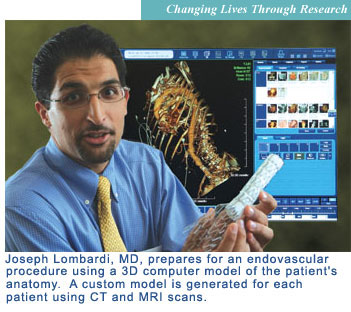
Article Title
Visualizing New Possibilities in Vascular Surgery
Recommended Citation
(2007)
"Visualizing New Possibilities in Vascular Surgery,"
Jefferson Surgical Solutions: Vol. 1:
Iss.
2, Article 5.
Available at:
https://jdc.jefferson.edu/jss/vol1/iss2/5
Included in

Assistant Professor Joseph Lombardi, MD is helping transform the treatment of Jefferson's vascular surgery patients. Since completing a vascular fellowship in 2003 at the University of Pennsylvania, Dr. Lombardi (JMC Class of 1996) has been practicing at Jefferson, stenting blockages and grafting aneurysms. This new and exciting field is called endovascular surgery, in which therapy is directed through catheters and wires within the blood vessels. The stents, which hold open the wall of the diseased vessel, along with endovascular grafts – fabric tubes used to make a new path for blood to flow – are placed inside a diseased vessel without traditional open surgery. This minimally invasive approach allows most patients to go home the same day.
Dr. Lombardi's main research interest involves diseases of the aorta. Aortic aneurysms can occur in the chest and/or abdomen, where a "bulge" develops in the vessel wall that can rupture and result in death if left untreated. Thoracic aortic dissection is a sudden event where the lining of the aorta tears, allowing blood to flow into the middle layer of the aorta, causing a cutoff of blood flow to vital organs. Endovascular surgery has revolutionized how these maladies are currently treated, and ongoing clinical trials look to improve minimally invasive options for these complex cases. Dr. Lombardi is the Global Principal Investigator of a multinational dissection study, sponsored by COOK Inc., to treat thoracic aortic dissection. This study, pending FDA approval, will explore procedures that cover the tear and support blood flow via a stent that holds the natural wall open. "This condition has plagued surgeons for decades," says Dr. Lombardi. "Acutely, the lining of the aorta is like wet tissue paper and is extremely hard to repair with open surgery, and if successful, the mortality rate is still about 50 percent." This new procedure offers many benefits without having to cut open the aorta itself.
"This technology is critical to the planning of all aortic reconstructions done in the entire practice."
Dr. Lombardi is also the director of a new aortic program at Jefferson, which combines vascular, cardiothoracic and cardiology expertise to evaluate patients with aneurysms and recommend the appropriate treatment. "The program makes it possible for patients with aortic disease to be thoroughly evaluated for all minimally invasive options and advanced clinical trials." Patients that are not eligible for such therapies can have traditional surgical approach.
Finally, Dr. Lombardi's office is the site of an exceptional piece of new technology: a three-dimensional TeraRecon workstation. The system, obtained in the spring of 2006, compiles CT scans and MRIs to create a composite image revealing layers of muscle, organ tissue and blood vessels. When preparing to do a stent graft for an aneurysm, Dr. Lombardi can examine the patient in this virtual sense with extreme precision to know exactly what to expect during the procedure. "Eighty percent of the surgery is done at this workstation beforehand," he explains, seated at his desk and rotating the vibrant, detailed images on the screen. "This technology is critical to the planning of all aortic reconstructions done in the entire practice," he says. "The procedures are becoming so sophisticated that detailed imaging and measurements are imperative to operative success."
An animation of a TeraRecon 3D patient model can be viewed at www.jeffersonhospital.org/aortic

